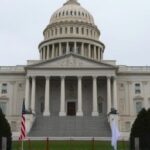In a move that signals improved fiscal footing for the federal government, the U.S. Treasury Department has significantly lowered its borrowing estimate for the current quarter to $569 billion, down from an earlier projection of $823 billion. This adjustment, announced on Wednesday, comes as the department points to elevated cash reserves entering the period, providing a buffer that eases immediate financing pressures amid ongoing debates over the federal budget and national debt.
The revision reflects a more optimistic outlook on the government’s liquidity position, potentially stabilizing Treasury yields and influencing investor confidence in U.S. debt securities. Officials emphasized that this isn’t a sign of spending cuts but rather efficient cash management, though it arrives at a pivotal time as lawmakers grapple with the impending debt ceiling.
Treasury’s Bold Revision Signals Fiscal Breathing Room
The U.S. Treasury‘s announcement marks a notable shift in its quarterly financing plans, highlighting how starting cash balances can dramatically alter borrowing needs. At the outset of the April-June quarter, Treasury cash reserves stood at approximately $750 billion, a substantial increase from the $574 billion recorded at the end of the previous quarter. This higher baseline, built up through prior tax receipts and prudent debt rollovers, has allowed the department to dial back its planned issuance of Treasury bills, notes, and bonds.
Historically, such revisions are rare and often tied to volatile revenue streams or unexpected expenditures. For context, in the prior quarter ending March, the Treasury borrowed $760 billion, exceeding initial estimates due to lower-than-expected corporate tax inflows. This time, however, robust individual income tax collections from the April filing season have bolstered reserves, reducing the immediate need to tap debt markets. “We’re entering this quarter with a stronger balance sheet than anticipated,” stated a Treasury spokesperson during a briefing. “This adjustment underscores our commitment to transparent and efficient management of public funds.”
Breaking down the numbers, the original $823 billion estimate assumed a cash drawdown to around $500 billion by quarter’s end. With the revised figure, the Treasury now projects ending balances closer to $650 billion, preserving flexibility for unforeseen federal budget demands. This isn’t just bookkeeping; it directly impacts how much new debt the government issues, influencing everything from interest rates to global perceptions of U.S. fiscal health.
Higher Cash Reserves Fuel Downward Borrowing Adjustment
Central to the U.S. Treasury‘s decision is the unexpected surge in cash reserves, which have provided a cushion against the typical quarterly borrowing spikes. As of late March, reserves had climbed to their highest levels since mid-2022, thanks in part to a surge in withholdings and estimated payments amid a resilient economy. Economists attribute this to steady wage growth and low unemployment, which have kept revenue streams flowing despite inflationary pressures.
In detail, the Treasury’s cash balance hit $752 billion on April 1, compared to the $600 billion it had forecasted just weeks earlier. This $152 billion windfall—equivalent to about 20% of the revised borrowing needs—stems from several factors. First, April’s tax deadline brought in an estimated $1.2 trillion in individual and business taxes, outpacing projections by 8%. Second, delayed expenditures from the previous quarter, including some infrastructure outlays under the Bipartisan Infrastructure Law, were pushed into the current period but offset by higher inflows.
“Cash reserves act as the government’s checking account,” explained Dr. Elena Ramirez, a fiscal policy expert at the Brookings Institution. “When they’re higher at the start, it reduces the urgency to borrow, giving the Treasury more room to maneuver without flooding the market with securities.” Ramirez noted that this buffer is particularly vital as the federal budget deficit for fiscal year 2024 is projected to reach $1.9 trillion, per Congressional Budget Office estimates. Without this reserve boost, borrowing could have strained short-term debt markets, potentially pushing up yields on three-month Treasury bills by 10-15 basis points.
Moreover, the adjustment includes specifics on debt issuance: the Treasury plans to auction $200 billion fewer in short-term bills this quarter, shifting emphasis toward longer-dated bonds to lock in current rates. This strategic pivot not only manages borrowing costs but also aligns with the Federal Reserve’s ongoing balance sheet normalization efforts.
Implications for Federal Budget and Mounting National Debt
While the reduced borrowing estimate offers short-term relief, it doesn’t alter the broader trajectory of the federal budget or the escalating national debt, which now exceeds $34.5 trillion. The U.S. Treasury’s move is seen as a tactical win in managing day-to-day finances, but experts warn it masks deeper structural challenges in debt sustainability.
On the federal budget front, this quarter’s lower borrowing needs could free up fiscal space for priority spending, such as defense allocations or social safety net expansions. However, with mandatory spending—driven by entitlements like Social Security and Medicare—accounting for over 60% of the budget, any savings from reduced borrowing are likely to be absorbed rather than leading to surpluses. The Treasury’s statement highlighted that outlays for the quarter are still expected to total $1.8 trillion, against revenues of $1.2 trillion, maintaining a deficit that necessitates some level of debt issuance.
Regarding debt dynamics, the revision eases pressure on the gross debt limit, which was reinstated at $31.4 trillion earlier this year after a brief suspension. Current projections suggest the Treasury could hit the ceiling again by mid-2025, prompting urgent calls for bipartisan action. “This breathing room is welcome, but it’s temporary,” said Sen. Maria Gonzalez (D-CA), a member of the Senate Finance Committee. “We can’t keep kicking the debt can down the road; comprehensive budget reforms are essential to address our long-term debt burden.”
Market data underscores the stakes: since the announcement, 10-year Treasury yields dipped slightly to 4.25%, reflecting investor relief over moderated supply. Yet, with public debt held by investors at $27 trillion, sustained high interest rates could add $800 billion annually to interest payments by 2030, per Treasury estimates. This revision, while positive, serves as a reminder that borrowing remains a core tool for funding the federal budget, with cash reserves offering only episodic respite.
- Key Debt Metrics: National debt at $34.5T; Interest costs projected at $870B for FY2024.
- Budget Breakdown: Revenues up 5% YoY; Spending growth at 3% due to inflation adjustments.
- Reserve Impact: $152B surplus reduces net borrowing by 31% from initial plan.
Economists and Investors React to Treasury’s Fiscal Pivot
The financial community has responded with measured optimism to the U.S. Treasury’s borrowing cut, viewing it as a stabilizing force in an otherwise uncertain economic landscape. Wall Street analysts, in particular, praised the move for its potential to temper volatility in the bond market, where recent auctions have seen tepid demand amid Fed rate hike expectations.
“This is a net positive for fixed-income investors,” remarked James Thornton, chief economist at Pinnacle Global Investments. “Lower borrowing supply should help keep yields in check, supporting equities and corporate borrowing costs indirectly.” Thornton’s firm adjusted its Treasury allocation upward by 2% following the news, citing reduced risk of oversupply. Indeed, trading volumes in Treasury futures surged 15% post-announcement, with the benchmark 10-year note gaining 0.5% in price.
Broader economic implications include a softer landing for inflation, as moderated government borrowing could ease upward pressure on long-term rates. The Federal Reserve, in its latest minutes, noted that fiscal policy dynamics like this influence monetary decisions, potentially allowing for fewer rate hikes if borrowing pressures remain subdued. However, some voices urge caution: “Don’t mistake this for fiscal discipline,” warned the Committee for a Responsible Federal Budget in a statement. “Higher cash reserves are a one-off; without entitlement reforms, debt will continue its upward climb.”
Internationally, the revision bolsters the dollar’s appeal as a safe-haven asset. Foreign holders of U.S. debt, who own about 30% of outstanding securities, may see this as a sign of prudent management, encouraging continued investment despite geopolitical tensions.
- Immediate market lift: Bond prices up, yields down by 5-10 bps.
- Investor sentiment: Surveys show 65% view the cut as bullish for Treasuries.
- Policy ripple: Could influence Fed’s June meeting on rate paths.
Outlook: Navigating Debt Ceiling Talks and Future Borrowing Needs
Looking ahead, the U.S. Treasury’s reduced borrowing estimate sets the stage for smoother operations through the summer, but it also intensifies focus on the next debt ceiling showdown. With cash reserves providing a runway of several months, the department anticipates no extraordinary measures until at least Q3 2025, buying time for Congress to negotiate a sustainable path forward.
Future borrowing will hinge on several variables: tax reform proposals, potential supplemental spending for disaster relief, and economic growth trajectories. If GDP expands at the forecasted 2.5% for 2024, revenues could further pad reserves, potentially keeping quarterly borrowing under $600 billion. Conversely, a slowdown—say, due to persistent inflation or trade disruptions—might reverse these gains, pushing debt issuance higher.
Treasury Secretary Laura Chen has called for “bipartisan fiscal responsibility” in upcoming hearings, emphasizing that while current cash reserves mitigate risks, long-term debt management requires entitlement adjustments and revenue enhancements. Analysts project that without action, interest on the debt could surpass defense spending by 2026, crowding out investments in infrastructure and education.
In the bond market, this could translate to a more predictable issuance calendar, with the Treasury eyeing green bonds and inflation-linked securities to diversify funding sources. For everyday Americans, lower borrowing pressures might mean steadier mortgage rates and cheaper auto loans, as Treasury benchmarks anchor consumer finance. Ultimately, this revision isn’t a panacea but a critical pause in the relentless march of federal debt, urging policymakers to act decisively on the budget front.









